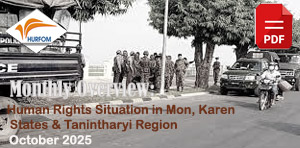UN Day of the Girl Child and eradicating the “black spot” of harassment
October 11, 2013
WCRP: Today marks the United Nation’s annual “International Day of the Girl Child” with the theme “Innovating for Girls’ Education.” This year, the UN is highlighting the roles that technology and innovation in policies, partnerships, and resource utilization play in advancing girls’ access to education, calling for “fresh and creative perspectives to propel girls’ education forward.”
These types of inventive solutions to cultural and logistical barriers to girls’ education are needed in Mon areas, particularly among the more rural and isolated communities along the Thai-Burma border. Many small villages have primary and middle schools, or monastic education centers, but students who want to continue on to secondary education, called 9 Standard and 10 Standard (informally called Grades 10 and 11), are not likely to have a local high school. Rural families are often required to fund daily transportation or shoulder the cost of a hostel so the students can live closer to the school.
“I completed Grade 9 at the Mon National Middle School in Khaw Zaw village in 2012,” said a student from Pope Htaw village in an interview last July. “My parents can’t afford for me to continue to Grade 10 because the Inn Din village [high] school in Ye Township is very far away and the school costs are expensive. My parents are poor and work on a rubber plantation and they are not interested in supporting or encouraging my education. For these reasons, I have to stop my studies this year.”
The distance between villages and high schools presents a particular challenge for girl students, namely found in the cultural aversion to allowing women to travel alone and the threat of harassment or sexual assault. Parents in rural areas reported not wanting their daughters to travel too early or late in the day and therefore often prevented girls from attending additional study sessions held in the mornings or after school. Many Mon community members agreed that parents are very strict with daughters, limiting their mobility as a means to keep them safe, whereas boys have fewer restrictions and are rarely taught to change the very behavior that creates the risks for young women.
Some girls said they feel attending school is not always comfortable or safe for them once they reach ages of 13 or 14. The attention they start to receive from boy classmates, coupled with families’ increased attention to their safety outside the home, is frequently interpreted as blame or some fault of the girls’. Interestingly, in community discussions about violence against women, boys reported that they consider comments they make to a girl about her appearance to merely be compliments that should encourage her. On the contrary, girls said the remarks about how they look incite feelings of shame and embarrassment because they believe no one would say anything unless they were doing something wrong to warrant it. To them, these comments serve as punishment for something that the community or culture deems incorrect.
While community members recognize these different experiences and parents perceive the hazards faced by young women among their male peers, the strategies to address the issue largely center around further isolating girls. Some villages have chosen to build separate school buildings that are fully enclosed and away from the boys, while other communities simply do not tolerate young women walking alone. This serves to reinforce girls’ sense that they are less capable than their male counterparts and creates justification for harassment should a young woman choose to go out without a companion. Rarely did people describe tactics that tackled the root of the problem: boys’ behavior and cultural or gender norms that disadvantage girls. Parents may resort to keeping a daughter home from school unless she has a chaperone to walk with, or decide it is not safe for her to travel to a neighboring village to continue her education, but may never talk to sons about the damage that verbal and physical harassment does to women and their communities.
One woman from a populous village in Ye Township described an experience she had in primary school when she was 11 years old. Her peers in 2 Standard were younger, mostly 8 or 9 years old, but because of the 1988 uprising in Burma her family had moved and she was placed below her age group at the new school. She said the difference in age did not bother her, in fact, she explained that she was very active in school and a leader among her classmates.
“It was the end of Buddhist Lent and there were many celebrations in the village, with shows and movies being shown in different homes. I was at a neighbor’s house with friends when the electricity went out, and someone behind me jumped up and put his arms around my neck and chest. At first I thought it was my friend but then I started shouting because I didn’t know who it was. Later, at school, a boy started following me around and one day he said something about being the one that touched me in the dark. I felt so much shame and didn’t want to tell anyone about what happened, and for six months I became shy and quiet at school, not at all like I was before. I felt a black spot was on me because of what happened.”
Notably, residents of several communities near the Thai-Burma border reported that their schools consisted of more girl students than boys due to the enormous impact that labor migration has had on the area. Boys as young as 11 or 12 supplement the family income by moving to Thailand or Malaysia to work on rubber plantations or in factories, often leaving their villages with more female than male inhabitants. However, while girls may be well represented in primary and secondary school classrooms, they allegedly face unequal conditions when applying for university degrees.
One graduate of the Rangoon Institute of Economics said, “There are different exam score requirements for girls and boys to get into university degree programs throughout Burma. When I took the 10 Standard Exam, I wanted to study agriculture and knew I needed a score of 350 to apply. Boys only had to score 340 to study agriculture. I scored a 345 and was unable to apply, so I studied economics instead because it required a 250.”
The young woman said the different score requirements hold true for most other academic programs as well, including medicine, engineering, IT, forestry, and English. Some former students said these lopsided qualifications help even the playing field since more girls appear to be finishing high school than boys, but others insisted that many jobs, particularly related to sciences and technology, were considered culturally unfit for women and the disadvantage was designed to keep them out of the traditional male sphere.
While an overarching issue in Burma remains the education system that fails to cultivate critical thinking or lead to meaningful careers among the country’s girls and boys alike, young women are not yet able to fully access or utilize education equivalently to their male counterparts. Improving educational outcomes for the country’s population must include innovations to school curriculums that integrate positive lessons about gender norms and encourage families to root out the source of discrimination against the girl child.
Comments
Got something to say?
You must be logged in to post a comment.




















































